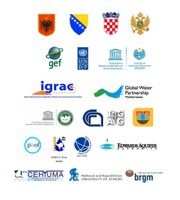The TDA – SAP process
A joint, transboundary effort needs to be undertaken to identify priority issues of environmental concern and to formulate an agreed Strategic Action Programme (SAP) prior to development of any technical assistance, capacity-building, or investment project. The countries sharing the aquifer, work together to produce a Transboundary Diagnostic Analysis (TDA) to identify the priority environmental concerns regarding transboundary waters and the causes to the problems arising from policies in the different economic sectors. Subsequently then formulate a Strategic Action Programme (SAP) to outline the actions needed to resolve the priority problems. The SAP contains necessary actions (including country commitments for implementation); it contains actions addressing transboundary issues that require funding through national commitments or by other means such as bilateral or multilateral assistance, loans, or through regular Implementing Agency programs; finally it contains additional actions needed to resolve the transboundary environmental concerns that have incremental costs that the GEF might fund.
Key elements of TDA and SAP
A TDA is an objective assessment and not a negotiated document. It uses the best available verified scientific and technical information to examine the state of the environment and the root causes for its degradation. The analysis is carried out in a cross-sectoral manner, focusing on transboundary problems without ignoring national concerns and priorities.
A key element of the SAP is the well-defined baseline case of needed interventions so that there is a clear distinction between actions with simply national benefits and those addressing transboundary concerns with their global benefits. Another key element involves the institutional mechanisms chosen at the regional and national levels for implementing the SAP.
Transboundary water-related environmental analysis. The process for cooperatively preparing a Strategic Action Programme (SAP) among countries starts with an analysis of priority transboundary environmental problems (through a TDA). Which drivers cause the actual degradation? What sectoral activities cause the degradation and how serious is this degradation? What are the information gaps on the existing environmental state, policy distortions and institutional deficiencies? Stakeholder analysis and public involvement are essential so that economic and social aspects will be included.
Relationship with national environmental planning and economic development documents. Responses included in national environmental documents and plans provide input in this analysis at the transboundary level. The analysis of the causes of degradation and the needs for capacity building include examination of national economic development plans and sectoral economic policies.
Establishment of clear priorities. The SAP will establish clear priorities for action; the actions will be endorsed at the highest levels of government and related information will be widely disseminated. The SAP will provide for a balanced program of preventive and remedial actions, support both investment and capacity-building activities, and identify key activities in the following areas: Priority preventive and remedial actions; Cross-cutting issues and linkages to other focal areas; Institutional strengthening and capacity-building needs; Stakeholder involvement and public awareness activities; Program monitoring and evaluation; Institutional mechanisms for implementation.
Establishment of a realistic baseline. The DIKTAS countries should agree on the baseline environmental commitments (which should be funded domestically or through donors or loans) and the activities necessary for solving the transboundary priority problems. It is important for activities included in the SAP to be realistically budgeted and consistent with projected availability of domestic and international funding. International, including European Union oriented, assistance may be appropriate when the SAP is in the draft stage to facilitate international commitments to action.


